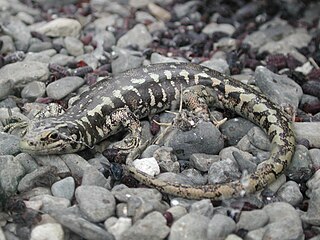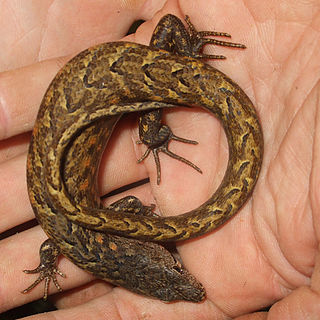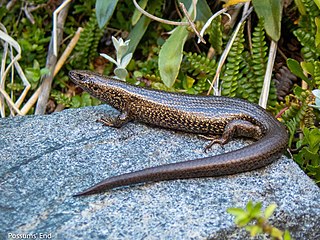
Oligosoma is a genus of small to medium-sized skinks found only in New Zealand, Norfolk Island and Lord Howe Island. Oligosoma had previously been found to belong to the Eugongylus group of genera in the subfamily Lygosominae; the Australian genus Bassiana appears to be fairly closely related.

The Otago skink is a rare, endangered species of large skink in the family Scincidae, found in the rocky canyons and grassy patches of Central Otago, New Zealand.

The grand skink is an endangered species of large skink endemic to the central Otago region of New Zealand.

Oligosoma alani,, also known as the robust skink is the largest endemic skink to New Zealand. The robust skink is in the family Scincidae and found in the protected nature reserves of the Mercury Islands in the North Island of New Zealand. The robust skink has an at risk - recovering conservation status.
The Lord Howe Island skink is a part of the native Australian reptiles’ classification. The Lord Howe Island Skink is a species of skink in the family Scincidae, located on Australia's Norfolk Island and Lord Howe Island. The Lord Howe Island skink population is uncommon to be found on Lord Howe island, however the majority of their population is located on the Norfolk Island complex.This skink is metallic bronze in colour and has flecks for defining features. It can grow up to 8cm in length, making them medium in size. Its taxonomy is diverse, the skink is a part of the Scincidae family, Oligosoma genus. This skink population is protected and considered vulnerable under the Environment Protection and biodiversity conservation act 1999.

McGregor's skink is a species of lizard in the family Scincidae. The species is endemic to New Zealand.

Whitaker's skink, also known commonly as Whitaker's New Zealand skink, is an endangered species of skink, a lizard in the family Scincidae. The species is found only in New Zealand.

Falla's skink, also known commonly as the Three Kings skink, is a species of lizard in the family Scincidae. The species is native to New Zealand.

The chevron skink, is a large species of skink endemic to New Zealand, found only on Great and Little Barrier islands in the Hauraki Gulf. A cryptic forest dweller, it can hide underwater, and is under threat from introduced rats.

Oligosoma infrapunctatum, the speckled skink, is a species of skink in the family Scincidae. It is endemic to New Zealand.
The small-scaled skink is a species of skink in the family Scincidae. The first specimen was captured in 1971 on Motutaiko Island, Lake Taupō but it is now known to be endemic to the central North Island of New Zealand in small population pockets. The holotype is in the collection of the Museum of New Zealand Te Papa Tongarewa.
Oligosoma taumakae, the Open Bay Island(s) skink, or Taumaka skink, is a species of skink. It was described from the Open Bay Islands, off the west coast of the South Island of New Zealand.
The Sinbad skink is a rare species of medium-sized skink endemic to New Zealand where it lives in an alpine habitat in Sinbad Gully, in Fiordland National Park.

The Barrier skink is a species of medium-sized skink, a lizard in the family Scincidae. The species is endemic to New Zealand, where it lives in the alpine habitat of the Darran and Takitimu Mountains of Fiordland. It is one of only two species of New Zealand skinks that live exclusively in the alpine zone, the other being the "Sinbad skink", Oligosoma pikitanga, a closely related species of similar appearance which is found in the same part of the South Island. The Barrier skink was first collected in the 1960s but was overlooked until rediscovery by a pair of mountain climbers in 2005; the species was scientifically described in 2009.

The Te Kakahu skink is a critically endangered species of skink native to New Zealand. When discovered, the entire species was inhabiting a single patch of clifftop vegetation on Chalky Island in Fiordland National Park.

The brown skink is a species of skink native to New Zealand.
The cobble skink in the family Scincidae is a skink species endemic to New Zealand, found only on a single small stretch of stony beach at Granity, on the West Coast. In 2016 it was on the brink of extinction, with declining numbers and a threatened habitat, and all known individuals were captured and taken to Auckland Zoo.
Fiordland is a geographic region of New Zealand.

Oligosoma awakopaka, the Awakopaka skink, is a rare species of skink found in New Zealand. It can reach a snout-vent-length (SVL) of up to 77 mm and has a glossy, vibrant brown-yellow dorsal surface flecked with black, and typically sports a faint pale dorsolateral stripe edged with black. The ventral surface is vivid yellow and flecked with black as well.

The Chesterfield or Kapitia skink is a species of skink found in New Zealand. Only discovered in 1994 and for years not recognised as a distinct species, it is endemic to a narrow 1 km strip of coastal vegetation on the West Coast of New Zealand, 15 km north of Hokitika. There are fewer than 200 individuals remaining in the wild. Oligosoma salmo is the only New Zealand skink with a prehensile tail, suggesting it was once arboreal and inhabited coastal forest, which was subsequently cleared for dairy farming. Following the partial destruction of its remaining habitat in 2018 by a cyclone, a small captive breeding population was established at Auckland Zoo.














